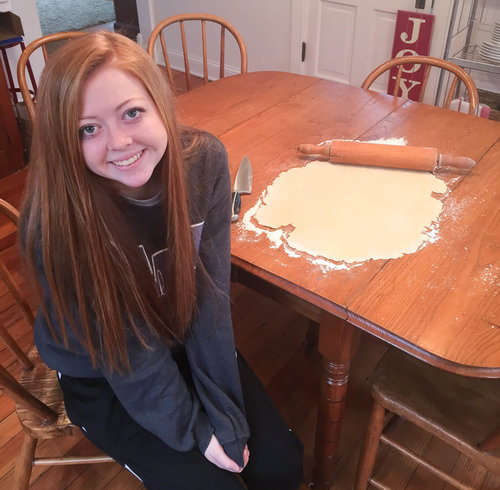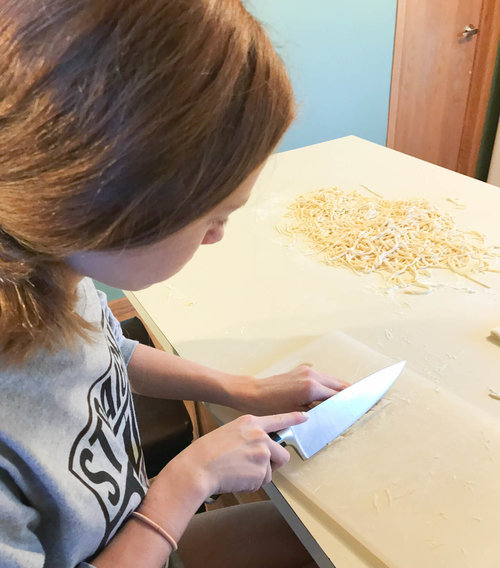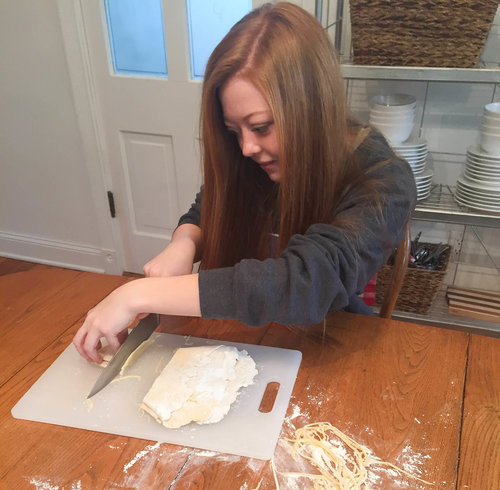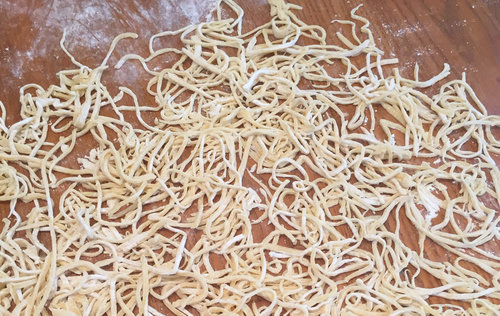Our Noodles – A Family and Farm Legacy
March 12, 2018
Just like any great recipe, the story of its legacy always trumps its ingredients.
Such is the case of my homemade noodles.
The truth be told, though, I consider them to be my mom’s noodles. She considered them to be her mom’s noodles. And my grandmother considered them to be her mom’s noodles.
I never met my great-grandmother Rivenburg, but I feel like I know her. I imagine she felt the same gratification of having everyone around the table, especially at the end of the day, as I do. The times may be vastly different, but I believe the core of who we are is very similar.




I come from a long line of farm women. In fact, I’m the first generation in my family to raise my children in the suburbs. However, my heart has always been, and will always be, rooted in agriculture.
One of my greatest intentions in life is to raise my four daughters to be educated, positive advocates for agriculture in whatever career field they chose. There is a continual need for collective voices to tell the story of our farmers.
Perhaps my girls will grow up to be doctors or architects. Or, maybe someday they will tend their gardens and raise their children. Whatever the future holds, I believe they will feel connected to their ancestors in the same way I do when they make my noodles.
Family Secrets
As my mother taught me, I am teaching my girls how to make the infamous homemade noodles.
It’s not unusual to have a double batch of noodles drying on the countertop, especially around Thanksgiving and Christmas. However, a meal with noodles isn’t saved for special occasions. They are requested around my house on a regular basis. The noodles are a family favorite, so it’s almost easier to put the extra time into making one big meal instead of lots of little ones.
Everyone participates. From measuring the flour to peeling the potatoes, we turn the meal prep into a little party. Kitchens are for dancing. I learned that from my mother, and my girls have learned that from me. Mom always told us kids that work could be fun, and when it’s fun, it doesn’t even seem like work.
After all the ingredients are added and the dough is kneaded, the real magic happens. The tools of the trade are key to perfect noodles.
For example, I like my rolling pins old. The heavy kind – the ones found in antique stores already perfectly colored with patina.
I like to think about the women who once used them as I roll out the mixture on the floured counter. The previous owners of the tool were slightly round in my mind’s eye, with toned upper arms from manhandling the rolling pin. Unlike the modern-day versions, old rolling pins weigh a lot. Nice and sturdy.
When rolling out noodles, watch your flour on the counter. It’s a fine art to use just the right amount so your noodles don’t stick together but also don’t become too tough.
And, the biggest secret of all – Grandma Rivenburg cut her noodles paper-thin using her butcher knife. The thinner the better. Gauge the knife against the first knuckle of your left hand and work slowly.
My grandmother boiled her noodles in the chicken broth that came from the roasted chicken that was raised in her backyard. Although I don’t do that myself, I have no doubt it enhanced the overall quality of the noodles.
As modern conveniences have become readily available, the recipe has evolved to include purchased eggs and even canned chicken, but don’t ever comprise on the sharp butcher knife.
Meal Blessings
When my family and I are all around the table, it’s our tradition for supper-time conversation to focus on the positives in our lives.
“What was the best part of your day?” I prompt.
More times than not they answer, “Right now.”
Maybe it’s the noodles. Maybe it’s our Rivenburg genes that just make us happy being together. Our lives may be starkly different, but the legacy of the women in our family is as strong as ever.
Noodles With Chicken or Beef
- 2 c. flour
- 3 egg yolks
- 1 egg
- 2 tsp. salt
- 1/3 c. water
- 1 (49.5 oz) can beef or chicken broth
- 1 (14.5 oz) can beef of chicken broth
- 1 (12.5 oz) can Tyson Premium Chunk Chicken or 2 lbs. beef stew meat, cooked in crock pot
Directions
Place flour and salt in a bowl. Make a well in the middle. Beat egg yolks and the whole egg with a whisk. Beat in water. Pour into well in flour mixture. Take a fork and mix up as well as you can and then knead with your hands until well blended. Shape into a ball and roll out on a floured surface. Flour surface of dough and fold in half. Flour again. Fold again until folded into eights. Flour well between layers so it doesn’t stick together. Cut very thin with a butcher knife on your cutting board. Put into boiling chicken broth and chicken. Stir well. Boil on low for about 30 minutes. Stir occasionally to keep from sticking. Serve over mashed potatoes.
Editor’s note: Ann Clinton, editor of the Iowa Soybean Review, is a Massena native. She lives with her family, which includes four daughters, in Waukee. March is National Noodle Month and Clinton plans to make many batches for her girls in the days to come.